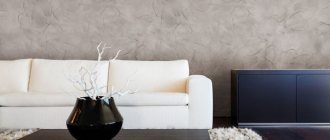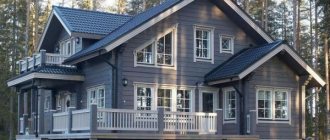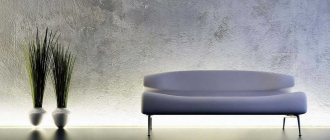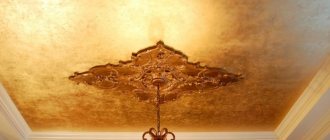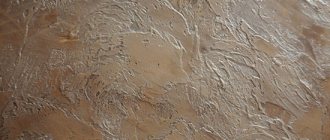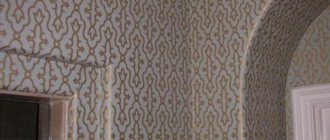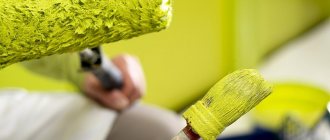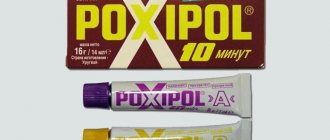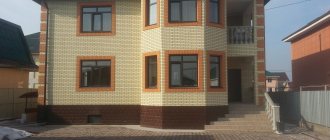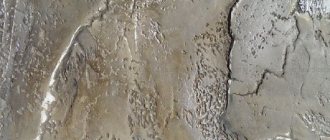Undoubtedly, white ceiling paint has been and remains one of the best options for decorating the space above your head. Matte white fills the room with light and air, this is known even to people who are far from apartment design. But those days when the choice of color and texture of the ceiling surface was limited to whitewashing or painting with water-based emulsion are long gone. A modern painted ceiling is not just practical in everyday life, it creates a mood and makes an impression on those present in the room.
Working with textured coatings requires considerable experience
Colors and textures
Emulsion paints not only have undeniable advantages in use, but are also distinguished by bright, saturated colors and a large palette of colors. In addition, they all have different visual effects. There are matte, glossy, semi-gloss and textured mixtures. Let's look at their properties in more detail.
When painted with matte paints, a non-shiny, uniform coating is obtained that can hide any defects in the ceiling surface. This type of coloring has long become traditional due to its versatility and elegance. Matte paints have a porous structure that quickly becomes dirty and is difficult to clean. Any, even the smallest stains will be visible on it, so you should carefully choose the type of paint and its color.
When painted with glossy paints and varnishes, the ceiling turns out shiny, which looks especially impressive on large areas. This type of painting is only suitable for perfectly smooth ceilings, since all the imperfections and defects of the original ceiling covering will be clearly visible on the glossy surface. Thanks to the mirror effect of the paint, you can visually enlarge the room, so it is an excellent option for use in small apartments.
This ceiling is easy to clean - the glossy paint is resistant to moisture, and dirt and dust do not settle on it so much. Even if heavily soiled, the glossy coating can be easily cleaned; just wipe with a damp cloth and the ceiling will sparkle again.
Many consumers opt for semi-gloss compounds. This is a kind of compromise between matte and glossy painting - the coating will shine, but not as much as with the previous option. The advantage of using such paints is the ability to select the optimal composition based on the degree of gloss.
Textured mixtures have remained the most popular paints for many years. Their range is represented by many varieties of products, which include a special component that gives the surface a unique structure. The most commonly used are mineral fibers and polymer chips. By adding sawdust, sand or water, you can achieve a certain effect, for example, roughness or blurriness.
Using textured paint, you can get the effect of “velvet”, “flock”, “moire coating”. Skilled craftsmen use it to create a coating that imitates natural stone and various mineral materials.
It is worth noting that this paint is not so easy to use and additional equipment will be required to achieve a high-quality result.
The best ceiling paint - a review of manufacturers
Let us repeat in the statement that choosing the best paint based on all indicators is difficult, almost impossible. Each of them has its own pros and cons; the best one can be determined only by one or two indicators. For example, a paint that is excellent in coverage and water resistance will turn out to be too “fragrant,” while an environmentally friendly and vapor-permeable paint will not be tinted well. Therefore, we will limit ourselves to only a brief overview of the best manufacturers, indicating the advantages of their paints.
Snowball
Polish paints are distinguished by their practicality, low price, and ease of use. They are available in a wide variety of types and you can find compositions for concrete, drywall, wood, and plaster. This allows you to cover a ceiling made of dissimilar adjacent materials with one paint.
“Snezhka” paint was appreciated by both professionals and people who use it in household repairs. For a family budget, there is practically no better choice than to paint the ceiling like Snezhka. The best paints for the ceiling are the “Disney”, “Ultra Belle”, “ECO” series.
Dulux
Professional paints with increased environmental safety. For ceilings, special compositions are very convenient, which have a pink color when applied, and after drying they become perfectly white. This allows you to avoid unpainted areas against the background of a white primer or the first, already dried layer of paint. Some compositions contain silver ions, which prevent the appearance of mold and mildew on the ceiling.
For paints, Dulux offers a wide selection of dyes collected in the Dulux Color Palette catalog. You can see how the ceiling will look under different lighting using special computer programs developed by the company.
Tikkurila
One of the most famous companies in the world of paints. The products of the Finnish concern belong to the elite of paint and varnish materials. You can choose paints for any materials that are tinted in Tikkurila Symphony colors (20,000 colors), OPUS 1 (2436), Monicolor (2024) and several dozen other options. All paints are of the highest quality and, naturally, quite high in price. As a rule, paints from the Finnish brand are used in designer renovations when decorating exclusive interiors.
Tex
Budget paint from the Finnish concern Tikkurila. It is produced both in Finland and in Russia for wide use, most often for household repairs. They do not require highly qualified builders, but the results from using TEX are not too impressive. But given the affordable price of paint, updating the ceiling every 2 to 4 years is quite acceptable for any budget. Good paints in white form and for tinting in rooms with a normal and dry microclimate. For kitchens, bathrooms, and offices, it is better to choose more expensive paint.
Caparol
Given the current market situation, the Caparol brand is holding very confidently, not inferior in popularity to Snezka and even surpassing it. But the price of this paint is significantly higher. The German brand Caparol produces environmentally friendly interior paints for various purposes. Latex and silicone compounds of the CAPASILAN, Indeko-Plus, Samtex and others series are intended for ceilings. They are perfectly tinted using the ColorExspress system and are distinguished by the durability of the coating and exceptional color fastness.
The advantages of this finish
The most important advantage of this design method is the ability to hide quite significant defects and flaws. This is true not only for ceiling planes, but also for walls. However, for ceilings this point is most important.
To perform such finishing, there is no need to carefully level the surface - the texture obtained after using such materials will reliably hide all imperfections. Of course, there are certain limits to their capabilities, but most minor defects can be hidden quite successfully.
To work and finish with such materials, you do not need complex tools or any special skills - just basic knowledge and a minimum of skills and you can achieve excellent results. The textured paint chosen for finishing the ceiling will allow you to get the same texture as in the next photo.
Errors and their elimination
One of the most common mistakes made when finishing the ceiling is saving
- Unqualified putty of the ceiling area.
- Uneven application of the first paint coat.
On the white background of the ceiling, efflorescence may appear - spots that have a yellowish color. Tip Sometimes traces of the bristles of a brush or roller are found on the surface. This happens due to the use of too thick paint. The fragment must be thoroughly cleaned with sandpaper and then repainted.
Painting without streaks
Experts recommend adhering to the following algorithm of actions
It is better to make the first layer of paint thin. It is better to dilute the composition itself a little. The next layer of paint is applied undiluted, in the direction from the walls to the center of the ceiling
It is important to wait until the previous layer of coating has completely dried before applying the next one. Otherwise, you may end up with a dull, uneven ceiling.
Another way to paint accurately is with a spray gun. Ceiling finishing plays a key role in the design of the room. It is necessary to carefully select materials, style and surface design. On our website you will find complete information about the pros, cons and installation of “Starry Sky”, Armstrong ceilings, as well as slatted, wooden, plasterboard, fabric, aluminum, stretch and board ceilings.
What tools can you use to work?
What the finished surface will ultimately look like depends not only on the type of paint and varnish material, but also on how it is applied. Many formulations come with instructions for use. But for most textured paintwork materials, you can use a variety of tools. Thanks to this, you can obtain types of textures that differ from each other:
roller (standard). By evenly moving it over a fresh layer of paint, you can get an attractive-looking rough texture;
The type will depend on the material of the roller (foam rubber or fur).
- roller (curly). This is a special roller with a convex pattern. Often used for two-tone painting. The first layer of paint becomes the background, and the roller pattern is applied with paint of a different color. If treated from floor to ceiling, the result may be decorative painting of walls instead of wallpaper;
- crest. With its help, you can get a clear pattern if you simply move it over the newly applied paint. But this method is chosen quite rarely;
- brush/brush. After applying the composition to an area of one and a half to two “squares”, you need to take a brush or a wide brush with stiff bristles and move it over the paint, creating patterned lines. You can choose any direction;
- crumpled paper, crumpled fabric. With their help, you can apply a chaotic pattern with short, stamping movements;
- latex gloves. A non-standard tool, but also used quite often. Mainly by artists who prefer to paint with their fingers on walls;
- putty knife. The first step is to apply a thin layer of paint to the wall. Then, using a spatula, make sparse and rather rough strokes. The last application method is used quite rarely by beginners due to its complexity.
When working with textured compositions, you can not be afraid of experiments. For example, apply strokes of different colors or shades to the surface, and then shade them with a sponge. This way you can get a completely new pattern. However, it is worth considering that you should spend no more than a quarter of an hour on any decor. Then the paint and varnish material begins to dry out and it becomes more difficult to work with.
Therefore, professionals advise treating surfaces in parts or working in pairs - one applies the background, the other decorates.
Preparatory work
Painting corners with a paint brush
It is wrong to think that painting the ceiling with a roller can be done without using a paint brush and other materials.
For this process we will need the following components:
- wide brush for painting;
- special plastic dishes;
- handle for attaching the roller;
- masking tape.
Surface preparation
The process of painting the ceiling with a roller is considered final, so you should carefully prepare for it. And the use of paint, no matter how carefully the work is performed, is fraught with some contamination. Before you paint the ceiling with a roller, you must first:
- remove all furniture from the room or, as a last resort, protect it using film;
- remove all lighting devices or close them;
- after removing the lamps, it is necessary to carefully insulate the exposed parts of the wires;
- protect the floor surface;
- Using masking tape, seal those places where paint should not come into contact.
Removing old paint from the ceiling
Preparing textured paint
Before using textured paint, you should carefully study its instructions, which indicate the drying time, preparation procedure and application tips. Mostly such mixtures are sold in plastic buckets.
Its consistency is impressively dense, which is why a small amount of water is added to it before application, after which mixing is carried out using a drill with a mixing attachment installed. In this case, the main thing is not to pour more liquid than necessary, since as a result the product may no longer fully adhere to the base due to its excessive rarity, for example, on the ceiling. When diluting, experts do not recommend adding more than 1/10 of water relative to the total volume of the mixture. In practice, on average, 4% is enough for optimal stirring.
If, according to the plan, the surface should be painted in a color other than white, then a suitable pigment is added to the mixture.
After each portion, you need to pause, stirring and checking the resulting shade for consistency. If the color is still too light, you can continue adding pigment. To check the degree of color intensity, a stroke of paint is applied to an unnecessary piece of wallpaper or other material, which can be dried with a hairdryer to dry quickly. The best quality of pigmentation is achieved by adding a color from the same manufacturer that produces the paint used.
What is this paint?
In its composition, it is not too different from the usual one. A lot of special filler has been added to it, giving the painted surface a grainy texture. The filler can be different, but usually it is quartz sand or granules of a similar material.
The composition also contains a special binder that gives the solution thickness. It is precisely because of its thick consistency that it can be applied in a fairly thick layer, giving the surface relief. Large amounts of sand or other fillers are not added to such solutions, since the texture of the surface is imparted in other ways.
Advice: if you plan to add dye to the composition, you should immediately dilute such an amount of solution that will be sufficient to paint the entire surface. It will be almost impossible to achieve an exact color match when breeding a new batch.
No dye is added to the standard composition. It can be purchased separately and added immediately before starting work. You can go the other way - paint a surface already finished with such material. For ceilings, white varieties of textured paints are purchased.
Coloring
General remarks
It is recommended to apply the paint at a temperature not lower than +7 C. At lower temperatures it becomes too viscous and does not adhere well to the surface.
Before application, the ceiling paint is mixed. If you plan to apply it using a roller, it is diluted with water to the consistency of liquid sour cream.
Until complete drying (usually a period of approximately one day from the moment of application), textured paint should not be exposed to direct water. Simply put, if you want to clean up any splashes that accidentally hit the ceiling while cooking, wait until tomorrow.
The volume of paint is tinted with some reserve. Don’t forget: when tinting again, it is impossible to achieve exactly the same shade.
A surface with a knurled texture can be painted in any color with ordinary water-based emulsion. The most daring decisions are possible.
The paint is applied in one step to the entire ceiling. Key point: the area where you apply the paint coat should not border on dry areas.
Work order
- Clean the ceiling from dust and dirt.
- Prime its surface with primer. It should be slightly rough to the touch.
- The paint is applied with a wide soft brush, foam roller or spatula, depending on the desired layer thickness and consistency. IMMEDIATELY the surface of the paint that has just been applied will have a texture: it is rolled with a hard roller with a relief surface.
An alternative method is to texture the surface with a sponge, stiff brush or notched trowel.
Basic methods of adding texture to a painted surface.
Preparing the ceiling for painting
Before applying paint, you should level the ceiling.
Before you begin directly painting with your own hands, you need to clean and level the surface. The process is divided into several stages:
- Using a wet sponge or a special sanding machine, remove the old whitewash and clean the ceiling of accumulated dust.
- If there are bumps and depressions, it is necessary to level the surface using putty or cement. Find out more about how to putty a ceiling for painting.
- We go through sandpaper to achieve the most even ceiling possible.
- Apply the primer and wait for it to dry completely.
- If there are skirting boards, they need to be painted with a brush.
But before painting, do not forget to remove all the furniture from the room or cover it with film and lay newspapers or polyethylene on the floor. Now you can move on to the final stage.
Textured paint for walls and ceilings
We think we should figure out what it consists of.
In appearance, it is a thick, homogeneous mass with a thick structuring filler. If you put this name in a nutshell, it will sound like paint with sand.
Thanks to this filler, textured paint for walls and ceilings has the opportunity to create a relief pattern on the surface being treated.
Classification
The presence of a large amount of material on the country’s construction market and a large number of manufacturers imply classification of the material.
And it’s easy to divide or break it down into classes
It is important to consider the type of filler, the substance that performs the functions of the base and the area of application
The role of filler in textured paint is performed by natural or man-made minerals, calibrated to one size:
- marble chips;
- granite chips;
- quartz sand;
- crushed gas silicate;
- fibers of various polymers.
The binder of the building material can also be different. Film-forming substances can be used as a base:
- acrylic;
- silicone;
- silicate.
But the most important factor that determines the class is the grain size of the filler. It is divided into three categories:
- small – with a size of up to 0.5 mm;
- medium – from 0.5 to 1 mm;
- large – from 1 to 2 mm.
I think the area of application is also an important factor. There is paint for textured walls of the building's base and facade. Also in the arsenals of hardware stores you can find textured paints for interior work in your home.
Useful qualities
Textured wall paints are produced on the basis of aqueous acrylic, silicone and silicate dispersions, without the use of solvents. This circumstance minimizes the risk of harm to the human body.
The finishing material has many advantages inherent in decorative plaster:
- hides minor surface defects;
- does not require special preparation of the processed surface;
- has high atmospheric and water resistance;
- the completely dried layer has a high level of hardness and is used as an anti-vandal coating;
- surprisingly, having high hardness, it forms a vapor-permeable coating;
- can be painted as a finished coating or tinted during preparation for application.
All these qualities make textured paints an indispensable finishing element for renovating your apartment. Moreover, the application can be done with your own hands and in the shortest possible time.
In the near future, I hope to please you with a story about how to apply finishes to walls, ceilings and other surfaces.
Subtleties of applying acrylic paint
Application defects are corrected immediately, as the compositions dry quickly
- The paint for applying the second layer is made more liquid than for the first in order to slightly blur the previous coating and eliminate defects.
- You should not apply a second layer of composition if the first has not had time to dry, otherwise the coating will wash out.
- Before you start painting the ceiling, it is recommended to practice applying the mixture using a roller.
- It is recommended to apply foreign-made compositions in two layers, Russian ones - in three.
- If, after the painted surface has completely dried, serious defects are discovered, you should not try to paint over them separately. In this case, it is better to take sandpaper and sand the entire ceiling, but this technique is considered effective only when no more than 2 layers of paint are applied to the ceiling.
- There is no need to rush when applying the composition - a complete redo of the work will require a lot of time and money.
Acrylic compositions are a convenient and inexpensive option for painting ceilings in rooms for any purpose. If the composition is applied correctly, an even, smooth, beautiful coating will please the eye for a long time and protect the surface from damage.
What is better to paint the ceiling - acrylic, silicone or silicate?
The simplicity and quality of painting is determined, first of all, by what kind of paint you choose. Experts believe that water-based paint is ideal for ceilings. It guarantees a uniform and even coating on the surface being treated. Even a home craftsman who has minimal painting skills can achieve such a result without much effort.
The water-based emulsion has no unpleasant odors, dries quickly enough, and is non-toxic. And most importantly, it is characterized by an excellent level of adhesion to various types of ceilings. Water-based paint will adhere perfectly to a layer of plaster or putty, on a brick or concrete surface. The ceiling paint we are interested in can be acrylic, silicone or silicate. Compositions of the first type form a special film on the treated surface. It effectively traps water vapor, thereby protecting the ceiling from destruction.
Water-based emulsion for ceiling surfaces
Silicate compounds cannot stop fumes. But their service life is estimated at several tens of years. Silicone paints can be considered the most rational option for painting the ceiling. They are characterized by a thoughtful combination of low water absorption and increased vapor permeability. Let us add that water-based emulsion is usually divided into several varieties depending on the gloss level of a particular composition. From this point of view, it can be: glossy, semi-matte, matte.
One wrong stroke and all your work will go to waste - the ceiling will look sloppy and unattractive. But matte compositions are ideal for beginner painters. Such paints perfectly hide all sorts of flaws on ceiling surfaces. Working with matte paints is much easier than with glossy and semi-matte paints. When choosing a water-based emulsion, always remember this.
Review of manufacturers
The manufacturer Amourcolor produces high quality textured paints that are resistant to wear. Buyers are provided with 3 product options: Tactite with a suede surface or mosaic, Perlata with a pearl sheen and Escenta with a variety of undertones. All paints are water-based and environmentally friendly.
Domestic offers paints with various textures: embossed, “Mizuri”, “wet silk” and others. All products of high quality can be purchased at a competitive price.
The Russian company VGT has been producing paint and varnish products since 1992. It is possible to purchase various types of textured paints: facade and interior, water-based, crack-resistant.
The product is ideal for our climate. There are a lot of positive reviews about it. In the video below you can watch a master class on applying textured paint with the “Travertine” effect.
Manufacturer from France Blancolor supplies many types of durable materials for decorative wall decoration. Among them are translucent paint Essuyables, silk based on cellulose fibers Tradimurs, waxed plaster effect Effets Platre Cires and many other types.
Textured paints from the manufacturer Clavel have a variety of colors and perfectly imitate silk, brocade, and velvet on walls. There are different types of designs ranging from antique to modern. The composition uses environmentally friendly components.
Decorating the ceiling with marble patterns
New construction technologies today provide a lot of opportunities that make it possible to obtain surfaces with a variety of effects. For example, paint with marble chips looks like decorative plaster, and the cost of this option is significantly lower. There are several ways in which a surface can take on the appearance of stone. One of them is applying a spray with the effect of marble chips.
However, a decorated surface made in this way has a cheap appearance. Special relief painting will help make the surface marble. It is quite rightly believed that the technology for performing such work is quite complex.
However, if you familiarize yourself with the principle of application and do everything carefully, the effect of marble chips is guaranteed. One of the most well-known methods of decoration is the use of oil glaze.
This is a special texture paint for creating a marble surface. Its basis is glaze, which is diluted with linseed oil and white spirit (1:2).
Apply it to the dry ceiling in an even layer. Then a special pigment is added to the remainder, and after the first layer has dried, a second layer with spots and veins is formed. Shading of the marble surface is done with special brushes.
This is a rather complex method that requires some artistic skill, because not every person will be able to draw spots and veins that could be compared to marble chips. It is advisable that two people do the work, because the glaze dries very quickly.
Features of the solution
How does texture paint compare favorably with other ceiling coverings? Does she have any disadvantages?
Advantages
- Paint, like any water-based paint, is vapor permeable. The ceiling will not provide an impenetrable barrier to water vapor.
- Unlike hanging structures of various types, paint will not reduce the height of the room.
- The textured surface perfectly hides minor surface defects. The ceiling does not need to be leveled as carefully as in the case of conventional painting and, in particular, the application of any glossy coating.
- Textured paint coating is one of the cheapest ceiling coverings. The cost of repairing the ceiling with its help (of course, if you do it yourself) does not exceed 50-70 rubles per square meter, taking into account the cost of the primer.
Flaws
- Paint consumption is relatively high: up to a kilogram per square meter of surface. Which, in general, is quite natural: the paint is applied in a thick layer.
- To give the ceiling an attractive appearance using textured paint, certain skills are required. They are produced very quickly; but it is better, if you are painting the ceiling for the first time, to experiment first in the least noticeable place.
- Of course, it will not hide height differences and large irregularities. If the ceiling has serious defects, suspended and suspended ceilings are unrivaled in terms of time and effort.
- For private houses with wooden floors, textured paint is clearly not the best solution. Cracks at the seams are inevitable, even despite some elasticity of the acrylic resin paint layer.
Textured paints and putties work best on a primed concrete base.
Disadvantages of textured compositions
The main drawback of all such solutions is the same - too high a consumption. One square meter of finished surface may require more than a kilogram of material. Considering that the composition, although not too expensive, still costs money, in some cases it is better to use other finishing options.
This design of ceilings cannot be used in wooden houses. Seasonal shrinkage and other deformations of the building will cause irreparable harm to the appearance of the finished surface. Cracks will appear and the decorative layer may fall off.
To obtain a beautiful texture and pattern using compositions without granular filler, some training will be required - you will not be able to achieve a good result right away.
Application methods
Walls can be finished with any convenient tools. You can take a spatula or something else suitable, but painting the ceiling with textured paint is done mainly with rollers. First of all, this is due to the fact that applying thick and heavy solutions to the surface of the ceiling is not very convenient - they constantly tend to fall off or delaminate.
Some varieties can be applied with a spatula, but this requires some skill and experience. Therefore, if you are planning to finish your ceiling in this way, you need to choose those solutions that can be applied with a roller.
If necessary, you can thin the paint a little if it is initially too thick. Then it will be much easier to apply it with a roller. It is necessary to control the dilution process so that the consistency does not become too liquid - it loses its coloring properties and may become unsuitable for use.
General principles of use
Coloring is carried out according to all the basic rules provided for conventional coloring solutions. It is necessary to carefully prepare the surface for painting. Here, the same methods and techniques are used as for conventional paints.
Next, priming is necessary. Without using a primer, the applied decorative layer may peel off and will “stick” less well to the floor plane. In addition, priming reduces material consumption.
When painting, you should achieve the thinnest possible layer of composition. This will reduce material consumption and, most importantly, achieve exactly the texture that should be obtained as intended by the manufacturer. By neglecting this rule, many people themselves spoil the decorative layer - the result is an ugly and lumpy texture.
Otherwise, there are no particular difficulties when using this material. To better understand all the intricacies of its use, below is a video that shows how textured ceiling paint is applied and what the texture is after it dries.
Why you should choose water-based paints for ceilings
Water-based paints and varnishes are most suitable for interior decoration. I'll explain why.
The advantages of such compositions
- Water-based paints can be used to coat substrates made of all types of materials. It is undesirable to do this only with metal, since water can cause corrosion of the base.
Water-based paints contain no harmful substances.
- Such compositions are the most environmentally friendly and do not contain harmful substances. When painting the ceiling, there are no persistent sharp and unpleasant odors that cannot be removed for several days.
- To remove old water-based coating from ceilings, there is no need to use solvents or cleaners. You just need to wet the surface and after 7-10 minutes the paint can be removed with a spatula.
Using tint, white paint can be given any color.
- In most cases, waterborne types of coatings are produced in white, the so-called “base” color.
If necessary, you can purchase a variety of colors and tones for them:
- thanks to this, you can recreate any of the shades of the coating. This circumstance makes it very convenient to design the ceiling.
- white ceilings are the most common and are considered classic. However, now their colored finishes are becoming increasingly popular. It increases the aesthetics of the interior, naturally, if the color of the coating is chosen correctly and accents are made.
In terms of aesthetics, painting is at least not inferior to other ceiling design options. This type of cladding has a very low price. Thanks to this, painting is almost always cheaper than other finishes.
How to paint a ceiling with a roller: step by step process
Roller painting the ceiling is not a very labor-intensive process, since with a skillful approach and preparation, all finishing work can be completed in 2-3 hours. How to properly paint a ceiling with a roller - you can watch the video and painting tricks below if you decide to carry out this procedure yourself.
Painting the ceiling, in addition to a roller, cannot be done without the following tools:
- Paints of the desired shade;
- Paint roller;
- Finishing Brushes;
- Containers for mixing paint;
- Cleaning cloth.
Painting ceilings with rollers is divided into several stages. First of all, in order to properly paint the ceiling with a roller, you should clean the work area itself, wipe and dry.
The very last layer should be painted in the direction in which light enters the room
Next steps will be as follows:
- Applying a primer that has a transparent texture and improves the adhesion area of the paint to the ceiling. The primer can also be applied with a roller;
- The next step is to use a roller for water-based paint for the ceiling. It is dipped in paint, after which it should be rolled a little on the surface so that the excess paint is absorbed into the instrument itself.
- Painting must be done smoothly and without unnecessary movements in order to paint the ceiling with a roller without streaks, which is very simple to do. The paint is applied in one layer, then it is better to let it dry and apply a second one. This way the coating will be more uniform, and the paint consumption will be much less. All corners are painted with a brush, as it is more convenient for performing these procedures.
The most important trick in painting a ceiling with a roller is that each subsequent layer should be applied directly perpendicular to the previous one - this way the paint will lie more evenly and the joints will not be so visible.
Distinctive finishing features
As a building material, decorative textured wall paint is a thick mass (white or colored with pigments) with various fillers that create a relief texture when applied. The paint has the ability to hold the applied pattern until it hardens completely.
The thickness of the permissible layer of paint makes it possible to fill in minor surface defects, and the texture itself visually hides unresolved irregularities in the plane treated with this composition.
Combination of decorative items and decoration
Preparatory leveling of plastered walls for upcoming painting is a rather labor-intensive process. Often, plasterboard sheathing is used to speed up the deadlines. This solution leads to the loss of a certain part of the usable area.
The problem is solved by applying a decorative layer of paint, which only acquires an even more unusual and spectacular appearance from the play of the light flux on the relief pattern.
An example of a stylish interior design that is not demanding on the ideal base plane is shown in the photo:
Mastering the technology and methods of working with any textured paint is not very difficult, so if you have a complete lack of experience in construction and finishing work, you should decide to do this type of finishing yourself. First you need to practice on a sheet of plywood, a small and non-critical section of the prepared wall. The mixture has such a hardening period that it leaves enough time for the gradual application of the pattern and its correction if the master considers that something did not work out.
Characteristic advantages
In relation to other finishing finishing coatings, the advantages of painting walls with textured paint relate to both the decorative properties and the operational characteristics of the resulting front surface of the walls.
Among the main advantages are the following:
- the plasticity of the formed layer, which does not crack under deforming forces from the natural shrinkage of the house;
- dust-repellent qualities that facilitate cleaning during cleaning;
- moisture-resistant film that prevents the absorption of odors, the formation and proliferation of mold and fungi;
- frost resistance;
- resistance to ultraviolet radiation;
- high environmental friendliness, allowing use in bedrooms and children's rooms;
- application on all types of substrates (brickwork, cement and complex mortars, wooden materials, glass, metal);
- ease of changing the appearance to a different color during routine repairs.
Pattern obtained with polyethylene or wet cloth
The photo shows an example of a simple and undefined texture that will make minor defects in the base invisible or give a natural look:
Water-dispersion-based materials are universal, suitable for use in decorating a kitchen work area, a respectable living room interior, and a bright and colorful atmosphere in children's rooms.
Effect paint
Textured paints for walls with effects that enliven the atmosphere and look different when the lighting in the room changes have become very popular.
Compositions with the following capabilities are sold in ready-to-use form:
- Nacre. This paint can make a room brighter by softly reflecting the incident light. In cloudy weather in the autumn-winter period, the walls, reminiscent of silk, seem to radiate warmth. With a change in viewing angle or type of lighting, mother-of-pearl coatings change shades of color. For this reason the material is called chameleon paint.
- Velvet (velor). The paint's fleecy appearance is given by the inclusion of solid grains of various colors.
- Granite. The role of granite chips is played by acrylic granules of paints of different shades, which break against the wall when the material is sequentially applied when sprayed through a spray gun.
- Textured decorative mixtures. They contain mineral particles, shell fragments, fine sand and other characteristic additives. The label indicates what effect is intended by the manufacturer: coral reef, seabed, spectacular shiny relief.
Sand filler with mother of pearl
How to choose paint
When choosing paint, you must pay attention to the parameters specified by the manufacturer.
To choose the right paint, it is recommended to take into account the conditions in which the coating will be used - permissible temperature, humidity, etc. indicated on the label.
- Covering power. The recommended figure (the number of grams of mixture required to densely cover 1 square meter of surface) is 20-60 g. A mixture with these characteristics will make the previous shade invisible.
- Drying time. Acrylic paint usually takes 1-4 hours to dry.
- Consumption. The lower the composition consumption per square meter of ceiling, the cheaper the work will cost. The figure varies among different manufacturers - a liter per 9-13 square meters.
- Terms of Use. For unheated rooms it is recommended to use frost-resistant mixtures, for bathrooms - moisture-resistant, for kitchens - biostatic (protect against mold, fungi or other biological formations).
- Permissible degree of exposure. The parameter indicates the degree of impact the finished coating can withstand, and is designated by numbers from 1 to 5. Mixtures marked as “class 1” can withstand frequent washing with abrasive agents, and class 5 paints only require gentle dry cleaning.
The color and other aesthetic characteristics of acrylic paint are chosen depending on the characteristics of the interior. Typically, white compositions are used to paint ceilings, but do not forget that the definition of “white” may differ among different manufacturers. The package may contain a mixture of milky, grayish, pearl or other shades
When choosing a paint shade, it is important to remember that acrylic will darken slightly after drying.
Video - Acrylic paints
If you have no experience in repair work, it is better to choose paints that form a matte film - unevenness and defects are less noticeable on it. Glossy compositions require a perfectly smooth surface, and the higher the degree of gloss, the more errors will appear on the ceiling. In addition, there are textured and pearlescent compositions that look very original.
Related Posts
- Painting drywall: 4 finishing features
- Technology of painting wallpaper with water-based paint
- How to paint wooden furniture yourself
- Which roller to choose for painting the ceiling: types and features of products
- How to glue fiberglass correctly?
- Is it worth replacing wallpaper with paint in an apartment: what to paint with, is it possible to do the work yourself, and what paint to choose for the wall
- Cost of painting walls and ceilings
- Materials for painting wooden products
- Caring for matte and glossy stretch ceilings
- How to prepare silver paint from powder and drying oil
- How to glue wallpaper on painted walls: water-based, oil and acrylic coating
- Which roller is best for painting?
- Choosing paint for the bathroom ceiling and applying it
- Which roller to paint the ceiling: surface preparation, choice of paint and tools, subtleties of painting the ceiling
- Is it possible to paint the battery during the heating season?
- How to whitewash a ceiling with your own hands
- How to paint a ceiling with acrylic paint - technology
- Why line the roof and ceiling with clapboard and how to do it correctly? nuances of the procedure
- What paint to choose for heating radiators and how to paint them
- Is it necessary to prime the walls after the starting putty before the finishing putty?
- Liquid heat insulating paint armor
- 10 tips for those planning a kitchen renovation
- How to dilute color in water-based paint
- How to properly glue fiberglass to drywall with your own hands
- Top 15 ways to visually increase the height of the ceiling
Read with this
- Painting drywall: 4 finishing features
- Technology of painting wallpaper with water-based paint
- How to paint wooden furniture yourself
- Which roller to choose for painting the ceiling: types and features of products
- How to glue fiberglass correctly?
- Is it worth replacing wallpaper with paint in an apartment: what to paint with, is it possible to do the work yourself, and what paint to choose for the wall
- Cost of painting walls and ceilings
- Materials for painting wooden products
- Caring for matte and glossy stretch ceilings
- How to prepare silver paint from powder and drying oil
What should a roller be like for painting a ceiling?
Not every roller is suitable for painting the ceiling. This is due to the specifics of this surface: a large area, the need for smooth and even painting, inconvenient surface location
You should also focus on the necessary preparatory work before painting. It is necessary to carefully level, plaster and prime the ceiling
If you compare a roller with a brush, you can find a significant advantage of the first over the second:
- The brush, no matter how good it is, leaves streaks and streaks on the surface being painted. With a roller you can avoid this.
- The roller absorbs the paint, which saves time compared to a brush, which has to be dipped into the paint much more often.
- A roller paints a larger surface than a brush with the same energy consumption.
- With a special long handle for the roller, using this type of tool will be much more convenient than painting with a brush, which is not possible without a stepladder.
If we talk about the characteristics of a roller for painting the ceiling, the recommendations here are quite simple. For an ideal result, use a wide roller with natural fur bristles. The length of the pile also matters. Choose long pile, which absorbs more paint.

